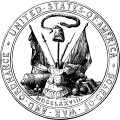References
- ↑ "Records of United States Army Continental Commands, 1821-1920".
- ↑ Pitcher, William L. (June 30, 1911). Annual Report of the Department of the Lakes. Washington, DC: U.S. Department of War. p. 55 – via Google Books.
- ↑ "Brig. Gen. Hoyt Weds Nurse. Commander of Department of Lakes, 62, Married to Miss Harbold, 32" (PDF). The New York Times . October 11, 1911. Retrieved 2015-04-13.
Following a romance that began not so very long ago in St. Paul, Brig. Gen. Ralph Wilson Hoyt, U.S.A., Commander of the Department of the Lakes, and Miss Cora McKeever Harbold of Dillsburg, York County, Penn., a trained nurse, were married this afternoon at the home of Mr. and Mrs. Thomas D. Richardson, 423 Wister Street, Germantown. ...
